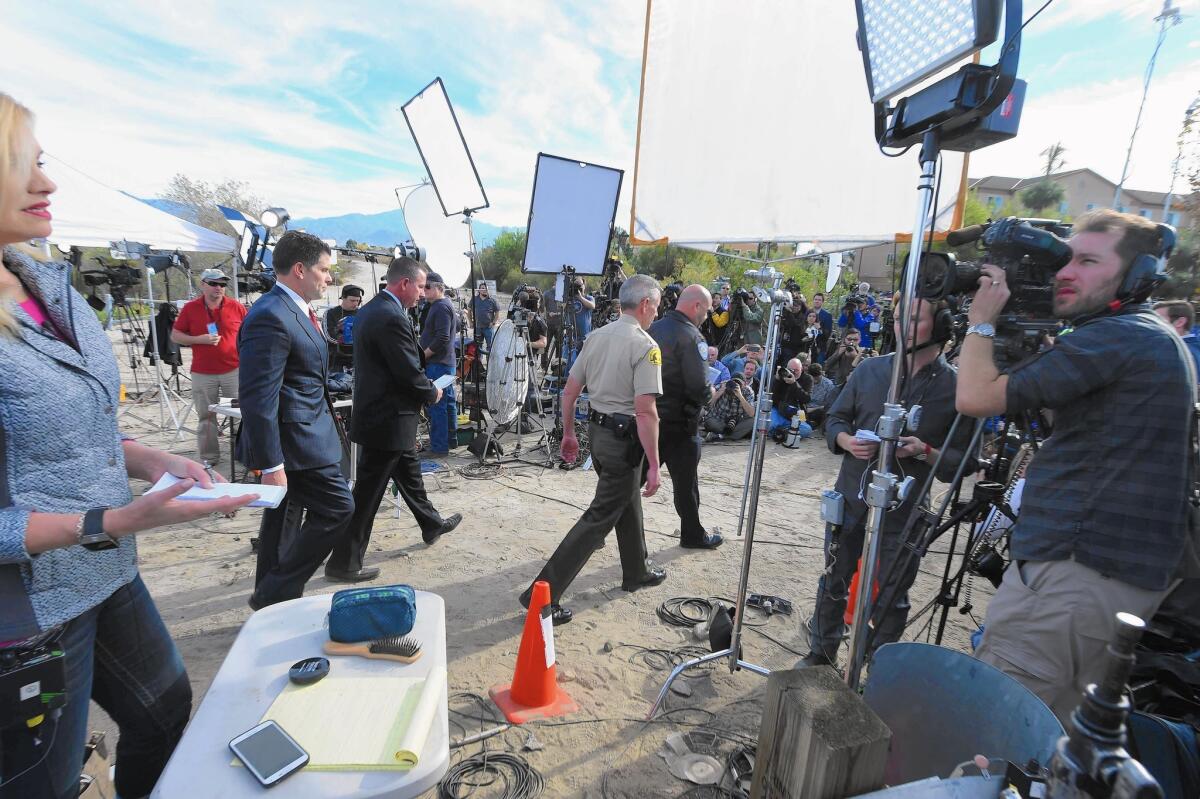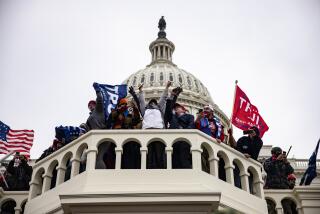San Bernardino shooting: Does blanket TV coverage change minds?

Media wait for law enforcement officials to begin a news conference after the mass shooting in San Bernardino on Dec. 3, 2015.
- Share via
Continuous television coverage of violent mass shootings is pulling at hearts, but not changing minds.
In June, nine people killed at Emanuel African Methodist Episcopal Church in Charleston, S.C. In October, nine dead and nine injured in a shooting at Umpqua Community College in Oregon. This week,14 people shot to death and 21 injured at a holiday party in San Bernardino.
Every tragedy is accompanied by hours of graphic video images of the wounded and grieving survivors. The law enforcement news conferences have become a familiar and dispiriting tableau.
Has the proliferation of incidents and the relentless televised coverage had any affect on public opinion?
Analysts say the parade of violence has only served to harden feelings on both sides in the battle over the gun control issue. Gun control advocates say the shootings underline the need to get guns off the streets; gun rights advocates say they show the need for Americans to be armed to protect themselves.
“It certainly riles people up,” said John Donohue, a law professor at Stanford Law School. “The question is, does it push views in either direction, or does it entrench people more in their current views?”
Public opinion polls have reflected the deep divide on the gun control issue. Following the Umpqua shooting, a Gallup poll showed that 55% felt that laws covering the sale of firearms should be more strict, while 11% thought they should be less strict and 33% believed they should be kept as they are. In contrast, shortly after the Columbine High School massacre in Colorado in 1999, 66% were in favor of stricter laws.
“The call for tougher gun control is actually short-lived,” James Alan Fox, Lipman professor of criminology, law and public policy at Northeastern University. “You can see on Gallup polls asking [about] tougher gun control that it spikes after certain cases, but it goes back down. And there are some people think we have the right gun laws, but we just need to enforce them.”
Franklin E. Zimring, a law professor at UC Berkeley, noted that mass shootings haven’t changed the intensity of support versus opposition at the national level in a way that translates into legislation. President Obama has called for tighter gun control measures, but Congress remains deeply divided over the issue.
“The reason that gun control laws do or don’t pass is not so much the number of people for or against it, but how deeply they feel,” Zimring said. “And for pro-gun, anti-more-control folks, it’s much more important to them — they care more deeply about their cause — than the average citizen.”
In an earlier era of television, the constant barrage of news footage from the Vietnam War helped turn public opinion against U.S. military involvement. But the division over gun laws is so intense that any television commentators looking to make the issue a crusade do so at their own risk.
When British journalist Piers Morgan had a nightly CNN program, he called for an assault weapons ban after the 2012 slaughter of 20 elementary school children in Newtown, Conn. He covered the story for seven consecutive nights, often stiff-arming the gun control opponents who appeared as guests. It prompted a petition to the White House with 80,000 signatures gathered by pro-gun activists that called for Morgan’s deportation.
“If the killings of elementary schoolchildren at Newtown did not galvanize the public around the issue, it’s not quite clear what it’s going to take,” said Andrew Heyward, former president of CBS News and currently a research affiliate for the Laboratory for Social Machines at MIT. “Even if the issue takes great prominence, which I think it will, there are diametrically different points of view on how to deal with gun violence, including arming citizens so they can shoot the shooters before cops get there.”
A fragmented media environment makes it less likely for any single individual media outlet or commentator to influence the debate on gun control measures. “No one owns the airwaves like Walter Cronkite did when he spoke to 30 million people,” said Joe Peyronnin, a Hofstra University journalism professor who worked with the legendary anchor at CBS. “There is no single voice that can stand up and make a call to action as a journalist. There is a lot of division around this and it’s not an issue of government distrust.”
Donna Dees Thomases, a former television publicity executive and longtime gun control activist, said the reflex of TV news is to present the causes of gun violence as a polarizing issue that requires discussion rather than a problem that needs resolution.
“I think by always framing it as a debate might be good for ratings or make you feel like you’re doing fair and balanced coverage,” she said. “But I don’t think it’s creating a public service. This is a story that needs to be told constantly, over and over again, without a mass shooting and having a bogus debate.”
The New York Daily News took such an approach with its blaring front page last week that called out political leaders — all of them Republican — for offering prayers for the San Bernardino victims but no call for action on gun control. “God Isn’t Fixing This” read the headline that became a talking point throughout cable news coverage of the massacre’s aftermath.
Daily News editor-in-chief Jim Rich did not see his tabloid’s front page as advocacy.
“When one side of an issue is so consistently lacking or predictable or in many cases duplicitous, it’s difficult to adhere to a traditional line in the sand as far as what’s being objective and what’s being subjective,” he said. “Right now we’re calling it exactly the way it is.” The New York Times may have taken its cue from the Daily News on Saturday with a call for stricter gun laws in its first front-page editorial since 1920.
Heyward believes any shift in opinion will probably be driven by social media platforms rather than traditional TV news. Coverage of San Bernardino turned to the terrorist links of the husband-and-wife shooting team Syed Rizwan Farook and Tashfeen Malik by Friday afternoon, as viewers were transfixed by a media tour of their apartment.
“As TV networks move on to the next story, which will they inevitably do, it will be interesting to see if social media interest in guns moves up,” Heyward said. “That would be a better measure.”
MORE ON SAN BERNARDINO SHOOTING
San Bernardino residents are weary and on edge after a traumatic week
Islamic State calls San Bernardino shooters ‘supporters’ as terrorism probe continues
Tashfeen Malik: A onetime ‘modern girl’ who managed to avoid detection before mass shooting
More to Read
Inside the business of entertainment
The Wide Shot brings you news, analysis and insights on everything from streaming wars to production — and what it all means for the future.
You may occasionally receive promotional content from the Los Angeles Times.












